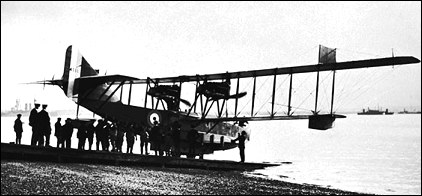|
| In 1914 Lieut J. G. Porte, Royal Navy, went to America to take part in the development of the Curtiss America flying-boat, in which an attempt at crossing the Atlantic was to be made. However, although the America had been completed, Porte returned to England in August following the outbreak of World War I, where he joined the RNAS.
Porte began to develop the Curtiss type of flying-boat at the Felixstowe station for possible use by the RNAS, concentrating mainly on improving the hydrodynamic qualities of the hull.
The first Felixstowe type was the F.1 (based on the Curtiss H.4), four of which were produced. The F.2 followed (designed around the Curtiss H.12) with a Porte hull and Curtiss wings and tail unit. Superior in every way to the H.12, it was produced in 1917 as the F.2A. It was one of the finest aircraft of the war and was widely operated as an anti-submarine patrol flying-boat until the Armistice. Armament comprised typically a Scarff ring mounting in the nose for one or two Lewis guns; a single Lewis gun on a pillar mounting at each of two beam positions; and one or two Lewis guns in a dorsal position aft of the wings. In addition two 104kg bombs could be carried under the lower wings. Nearly 100 F.2As were completed before the Armistice and the aircraft's fine performance and manoeuvrability also made it an effective multi-seat attack and anti-Zeppelin type.
| MODEL | F.2A |
| ENGINE | 2 x Rolls-Royce Eagle VIII, 257kW |
| WEIGHTS |
| Take-off weight | 4980 kg | 10979 lb |
| Empty weight | 3424 kg | 7549 lb |
| DIMENSIONS |
| Wingspan | 29.15 m | 96 ft 8 in |
| Length | 14.10 m | 46 ft 3 in |
| Height | 5.33 m | 18 ft 6 in |
| Wing area | 105.26 m2 | 1133.01 sq ft |
| PERFORMANCE |
| Max. speed | 153 km/h | 95 mph |
| Ceiling | 2925 m | 9600 ft |
| ARMAMENT | 4-7 x 7.7mm machine-guns, 2 x 104kg bombs |
| Ewoud Bon, e-mail, 01.06.2010 00:15 I own a picture of a Felixstowe flying boat at the 'ELTA' (First Airplane Exhibition Amsterdam) in 1919. The photograph was made by my grandmother Mrs.Wilhelmina Bon-Kat with a 9x12 camera. My father Willem Bon, 17 years old in 1919, made a small sketch of the same aircraft. I could send both by email if requested. reply |
| steve hailes, e-mail, 27.12.2006 16:57 I am interested in building a flying model of this and am looking for any photos etc anyone out there able to help? reply | | Reggie DeBono, e-mail, 14.02.2007 11:41 I have a very blurred photo of N4370 being launched in Malta. It is one of about 18 that were built around 1920 by the Maltese Dockyard workers. I am discussing with a potential sponsor to build a (non-flying)smaller fibreglass replica for sea-surface pleasure rides in the same bay 'Marsaxlokk - Kalafrana, Malta' where it used to be built. reply |
|
Do you have any comments?
|
| 
All the World's Rotorcraft |







Hi Ewoud,
I would very much like to get a copy of this picture!
Thank you very much in advance,
Gerrit Bon.
reply